
Psychotria viridis, also known as chacruna, chacrona, or chaqruy in the Quechua languages, is a perennial, shrubby flowering plant in the coffee family Rubiaceae. It is a close relative of Psychotria carthagenensis of Ecuador. It is commonly used as an ingredient of ayahuasca, a decoction with a long history of its entheogenic use and its status as a "plant teacher" among the Indigenous peoples of the Amazon rainforest.

Searsia lucida, previously known as Rhus lucida, and commonly known as the varnished kuni-rhus (English) or blinktaaibos (Afrikaans).
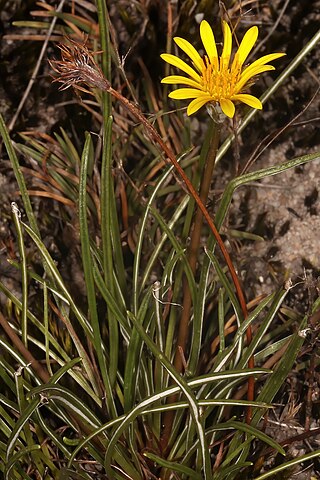
Gazania linearis is a species of flowering plant in the family Asteraceae, with thin linear leaves, native to South Africa.
This glossary of botanical terms is a list of definitions of terms and concepts relevant to botany and plants in general. Terms of plant morphology are included here as well as at the more specific Glossary of plant morphology and Glossary of leaf morphology. For other related terms, see Glossary of phytopathology, Glossary of lichen terms, and List of Latin and Greek words commonly used in systematic names.
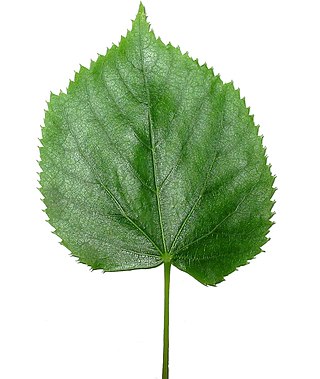
A leaf is a principal appendage of the stem of a vascular plant, usually borne laterally aboveground and specialized for photosynthesis. Leaves are collectively called foliage, as in "autumn foliage", while the leaves, stem, flower, and fruit collectively form the shoot system. In most leaves, the primary photosynthetic tissue is the palisade mesophyll and is located on the upper side of the blade or lamina of the leaf but in some species, including the mature foliage of Eucalyptus, palisade mesophyll is present on both sides and the leaves are said to be isobilateral. Most leaves are flattened and have distinct upper (adaxial) and lower (abaxial) surfaces that differ in color, hairiness, the number of stomata, the amount and structure of epicuticular wax and other features. Leaves are mostly green in color due to the presence of a compound called chlorophyll which is essential for photosynthesis as it absorbs light energy from the sun. A leaf with lighter-colored or white patches or edges is called a variegated leaf.

Myriopteris gracillima, formerly known as Cheilanthes gracillima, is a species of lip fern known by the common name lace lip fern. It is native to western North America, where it grows in rocky habitat from British Columbia to California to Montana.

Aloe ferox, commonly known as bitter aloe, is a species of flowering plant in the family Asphodelaceae. This woody aloe is indigenous to southern Africa. It is one of several Aloe species used to make bitter aloes, a purgative medication, and also yields a non-bitter gel that can be used in cosmetics.

Coprosma rhamnoides is an endemic shrub in New Zealand. It forms a small shrub up to 2 m tall. The leaves are very small, simple and variable in shape. The inconspicuous flowers are unisexual and believed to be wind pollinated. It is widespread in occurrence and can be the dominant small leaved divaricating shrub in some locations

Polyarrhena is a genus of low, branching shrublets that is assigned to the daisy family. Its stems are alternately and densely set with entire or somewhat toothed leaves. Like in almost all Asteraceae, the individual flowers are 5-merous, small and clustered in typical heads, and which are surrounded by an involucre of in this case three whorls of bracts. In Polyarrhena, the centre of the head is taken by yellow disc florets, and is surrounded by one single whorl of white ligulate florets that have a pinkish-purple wash on the underside. These florets sit on a common base and are not individually subtended by a bract. The species occur in the Cape Floristic Region. Polyarrhena reflexa has long been cultivated as an ornamental and is often known under its synonym Aster reflexum.

Zieria arborescens, commonly known as the tree zieria or stinkwood, is a plant in the citrus family Rutaceae and is endemic to eastern Australia. It is a bushy shrub or small tree with branches that are ridged and scaly or hairy, at least when young. It has leaves composed of three leaflets and groups of flowers with four white petals, the groups usually shorter than the leaves.

Pelargonium crispum is a Pelargonium species native to the Western Cape Province, South Africa. It is in the subgenus Pelargonium along with Pelargonium graveolens and Pelargonium capitatum and Pelargonium tomentosum.

Trochocarpa gunnii, commonly known as sweet-scented trochocarpa or fragrant purpleberry, is a common rainforest understorey shrub from the plant family Ericaceae endemic to Tasmania.

Felicia echinata, commonly known as the dune daisy or prickly felicia, is a species of shrub native to South Africa belonging to the daisy family. It grows to 1 m (3.3 ft) high and bears blue-purple flower heads with yellow central discs. In the wild, it flowers April to October.

Oedera capensis is a prickly shrublet belonging to the family Asteraceae. It has stems that branch only at the foot and are densely set over their entire length with narrowly triangular leathery leaves with a sharp tip at approximately right angles to the stem. At their tip are what at first sight appears to be a single flowerhead with yellow ray florets and yellow disc florets. In fact, these are mostly nine densely cropped heads, as is suggested by the nine domes of the "disc" of the composite head, the untidy arrangement of the ray florets, and becomes very clear when cutting through the composite head. It is an endemic of the south of the Western Cape province in South Africa.

Leucospermum hamatum is mat-forming, evergreen shrublet of only about 10 cm (3.9 in) high, from the Proteaceae. It is usually 1–3 m (3.3–9.8 ft) in diameter, has long trailing stems and upright, inverted lance-shaped, entire leaves but for one to five shallow reddish bony teeth near the tip. Its small flower heads of 1½–2 cm (0.6–0.8 in) in diameter, consist of four to seven drab carmine-colored flowers that strongly curve back to the centre of the head. It mainly flowers from July till November and is pollinated by mice. It has been given the common name Ruitersbos pincushion.
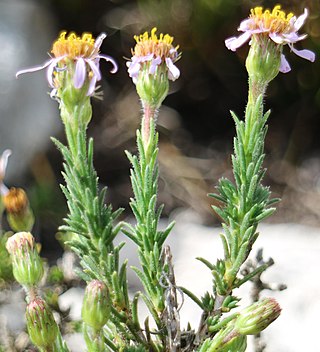
Felicia canaliculata is a grayish green shrublet in the family Asteraceae that grows up to 40 cm (16 in) in height. It has narrow, awl-shaped leaves, relatively large flower heads with approximately a dozen light purple to white ray florets encircling many yellow disc florets. It can only be found in the Western Cape province of South Africa.

Oedera squarrosa ("Vierkant-perdekaroo") is a prickly shrublet belonging to the family Asteraceae.
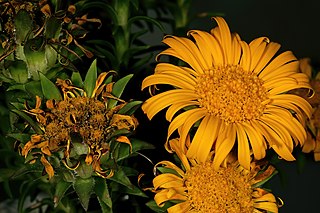
Oedera imbricata is a prickly shrublet belonging to the family Asteraceae.
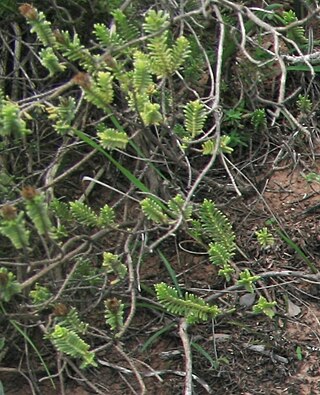
Oedera uniflora ("Kalksteenperdekaroo") is a prickly shrublet belonging to the family Asteraceae.

Gazania serrata is a species of flowering plant in the family Asteraceae, native to the Northern Cape and Western Cape provinces, South Africa.



















